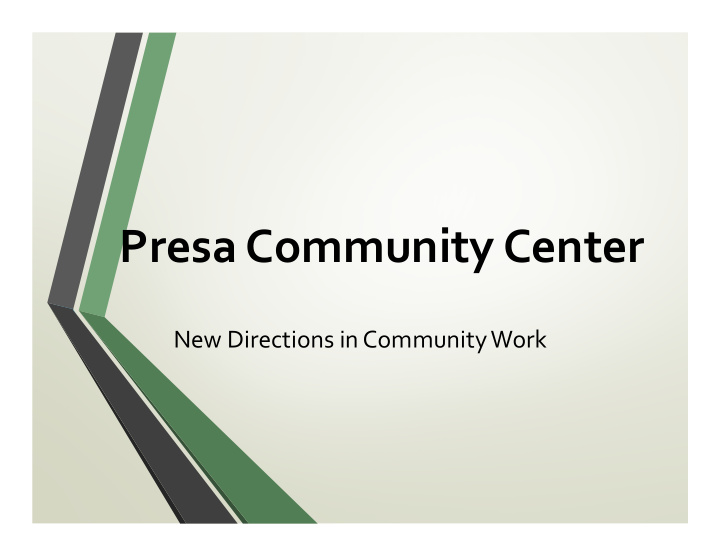



Presa Community Center New Directions in Community Work
• Who we are • What we do • Community Empowerment through job skills • Community Health Worker Certification • Project PUENTE (Bridges)
What is a Community Health Worker? CHWs are uniquely qualified as connectors because they live in the communities in which they work, understand what is meaningful to those communities, communicate in the language of the people, and recognize and incorporate cultural norms (e.g., cultural identity, spiritual climate, traditional health practices) to help community members navigate health care services. CHW’s serve as "bridges" (Puentes) between community members and health care services.
CHW (Promotora) History • Started in Latin American countries ‐ gained momentum in US in 60’s with Migrant Worker Communities • 2001 ‐ Senate Bill 1051 directed DSHS to develop and implement a CHW training and certification program • 2011 ‐ legislation directed DSHS to conduct a study with recommendations to maximize employment and access to CHW’s for individuals with public and private insurance • Jan, 2014 ‐ CMS has identified a CHW as a billable position with Medicaid/Medicare if part of Doctor’s prevention/treatment plan for patient
CHW certification mandates these 8 core areas of training • Communication Skills • Interpersonal Skills • Service Coordination Skills • Capacity ‐ Building Skills • Advocacy Skills • Teaching Skills • Organizational Skills • Knowledge on Specific Health Issues
8 classes since December 2012 • Presa approved as a training site in June, 2012 • 119 graduates • 95% currently working as CHW’s ‐ starting pay $15 per hour
Project PUENTE ‐ using a culturally sensitive approach with a fragile community Integrated patient care and disease management model, started in 2014 with a goal to redirect acute high ‐ risk patients with chronic diseases to the most appropriate care settings, using population health Top three diagnoses of participants: • Chronic Heart Failure (CHF) • COPD • Pneumonia
Project PUENTE • First year, 2 hospitals and CHF patients • End of year one, added 2 hospitals and COPD and Pneumonia diagnoses • 885 initial referral • 424 agreed to services/461 declined services • 267 completed • 26 readmitted within 30 days
Rate of Readmission • Nationally ‐ 24% • Baptist Hospital System ‐ 15% • Project PUENTE ‐ 11.6% • Adjusted PUENTE rate ‐ 7%
Characteristic All patients CHF Readmits ‐ all Readmits ‐ (n=223) (n=75 cause(n=26) CHF(n=9) Median age 69.0 68.96 39.10 70.3 No. of patients 26(11.66%) 9(12%) 26(100%) 9(100%) w/30 day readmit No. of patients 60(26.91%) 26(34.67%) 21(80.8%) 8(88.9%) in program 180 days with 180 day readmit RACE White 31 (13.90%) 11 (14.67%) 5 (19.23%) 1 (11.11%) African Amer 39 (17.49%) 14 (18.67%) 9 (34.62%) 3 (33.33%) Hispanic 152 (68.16%) 49 (65.33%) 12(46.15%) 5(55.56%)
Cost of Services Range of cost per patient for 30 day readmission ‐ $4,904 ‐ $7,121 Cost for Project Puente intervention per patient ‐ $920
Successful Interventions • In ‐ hospital CHW visit; individualized education plan based on client needs • Post discharge home visit 24 ‐ 48 hours and weekly telephone follow ‐ up call in ‐ between visits • Prompt scheduling and follow ‐ up with PCP/specialty care visits within 3 to 5 days of discharge • Medication access, self ‐ management, and adherence • Encouraging active participation and involvement of patient’s family/ caregiver • Greater health knowledge retention using the teach ‐ back method • Patient health record for care continuity
Supplemental Resources RESOURCE RECEIVED REFERRAL/APPLICATION RECEIVED 27 Exercise/ Health Equipment 6 40 Adult Protective Services Food 22 Food Demo 26 Long ‐ term food assistance 1 Home Repair Funds INTANGIBLES 28 Home health provider TANGIBLES 18 Medical Equipment 8 Home repair 55 Nutritional Information / Recipes 22 9 Housing Prescription Funds 2 27 Rent Assistance Senior program 57 Self ‐ Care 5 Smoke detector 51 Transportation 3 Utility assistance 5 Utility Funds 15 Other 5 Other
Trends Identified • Age greater than 69 years • Two or more comorbidities • Functional impairment e.g., physical, emotional, and cognitive • Past or current diagnosis of behavioral health issues, often untreated • Lack of understanding of discharge materials provided to the patient and/or family upon release • Inadequate support system e.g., housing, financial, and social
Lessons Learned • Expand time/meetings with patients who need more assistance • CHW becoming Benefit Enrollment Specialist to enroll those uninsured to allow for access to resources and care • CHWs added educational videos for use with patients/families • Interdisciplinary team –Transitional Care Coach, Social Worker, Community Health Worker, Caregiver, and providers are a key to success
Lessons Learned continued • Follow up calls 90 days after completion • Moved from traditional education to experiential education ‐ cooking demos • Including caregiver/family member/home health provider in educational component for greater support and impact • Attending appointments with clients to demonstrate and coach advocacy for oneself • Clinic visits more effective when CHW teaches patients how to prepare/what to expect and meets patients at clinic
WHAT NEXT?
Recommend
More recommend